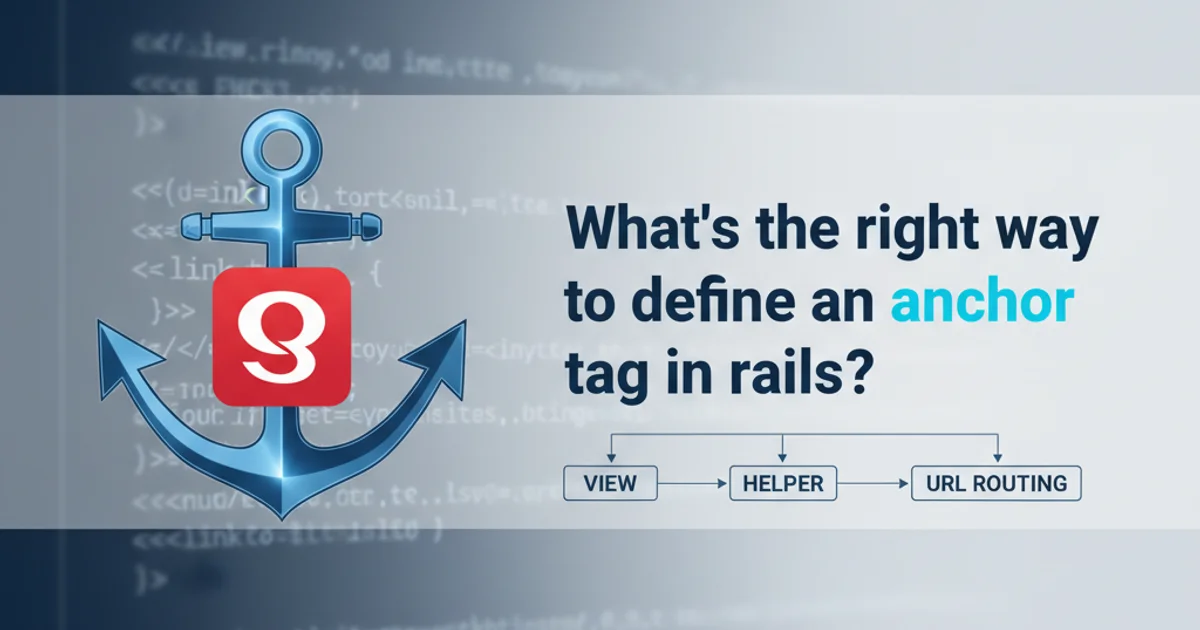What's the right way to define an anchor tag in rails?
Categories:
Mastering Anchor Tags in Ruby on Rails: A Comprehensive Guide

Learn the correct and idiomatic ways to define anchor tags (hyperlinks) in your Ruby on Rails applications, covering basic links, named anchors, and advanced helpers.
Anchor tags, or hyperlinks, are fundamental to web navigation. In Ruby on Rails, while you can always use raw HTML, Rails provides powerful view helpers that simplify their creation, enhance maintainability, and integrate seamlessly with the framework's routing system. This article will guide you through the various methods of defining anchor tags, from simple external links to complex internal navigation and named anchors, ensuring your Rails application is both user-friendly and robust.
The link_to Helper: Your Primary Tool
The link_to helper is the most common and recommended way to create hyperlinks in Rails. It generates an <a> tag, automatically handling URL generation based on your routes, making your code cleaner and less prone to errors when routes change. It's highly flexible, allowing for various arguments to define the link's text, destination, and HTML attributes.
<%= link_to 'Visit Google', 'https://www.google.com' %>
<%= link_to 'About Us', about_path %>
<%= link_to 'Show Product', product_path(@product) %>
<%= link_to 'Delete Product', product_path(@product), data: { turbo_method: :delete, turbo_confirm: 'Are you sure?' } %>
Basic usage of the link_to helper for external, internal, and action-oriented links.
link_to for internal application links. It leverages Rails' routing helpers (e.g., posts_path, edit_post_path(post)) which are more robust than hardcoding URLs and automatically adapt if your routes change.Linking to Named Anchors (Page Segments)
Named anchors allow you to link to a specific section within the same page or another page. This is achieved by adding a fragment identifier (the part after the # symbol) to the URL. In Rails, you can easily incorporate this into your link_to helper.
flowchart TD
A[User Clicks Link] --> B{Is Fragment Present?}
B -->|Yes| C[Browser Scrolls to Element ID]
B -->|No| D[Browser Navigates to Page Top]
C --> E[Page Segment Displayed]
D --> EHow named anchors direct browser navigation to specific page segments.
<!-- Link to a section on the current page -->
<%= link_to 'Go to Section 3', '#section3' %>
<!-- Link to a section on another page -->
<%= link_to 'Read FAQ on Pricing', faq_path(anchor: 'pricing') %>
<!-- Target element on the page -->
<h2 id="section3">Section 3: Advanced Topics</h2>
<h3 id="pricing">Pricing Information</h3>
Using link_to with fragment identifiers for named anchors.
anchor: 'your_id' as an option to the path helper. Rails will automatically append #your_id to the generated URL.Advanced link_to Options and Block Syntax
The link_to helper offers a rich set of options for customization. You can add CSS classes, data attributes for JavaScript interaction (e.g., Turbo/Stimulus), and even use a block to define the link's content, allowing for more complex HTML within the anchor tag.
<%= link_to 'Home', root_path, class: 'btn btn-primary', id: 'home-link' %>
<%= link_to root_path, class: 'logo-link' do %>
<%= image_tag 'logo.png', alt: 'Company Logo' %>
<span>Back to Home</span>
<% end %>
<%= link_to 'Edit', edit_post_path(@post), data: { turbo_frame: 'post_form' } %>
Examples demonstrating CSS classes, data attributes, and block syntax with link_to.
link_to or any HTML helper. Always sanitize or escape user input to prevent XSS vulnerabilities.